There are a number of different Bonsai styles that you can consider if you are shaping your Bonsai tree. Not only can you design your Bonsai tree trunk and foliage, but you can also choose the design of your tree’s surroundings. Caring for a Bonsai tree truly is an art form, especially when you take a look at all of the different possible styles used in traditional Bonsai tree formations.
In this article, we will go over all of the traditional Bonsai tree styles so that you can get inspired for your own Bonsai tree and container. Not only are these Bonsai styles designed to help your tree thrive, but they are also there to guide you on your own creative Bonsai tree journey! Let’s get started and go over the many different styles for you to consider for your Bonsai tree and its surrounding habitat.
Bonsai Styles: Types and Shapes for Your Bonsai Tree
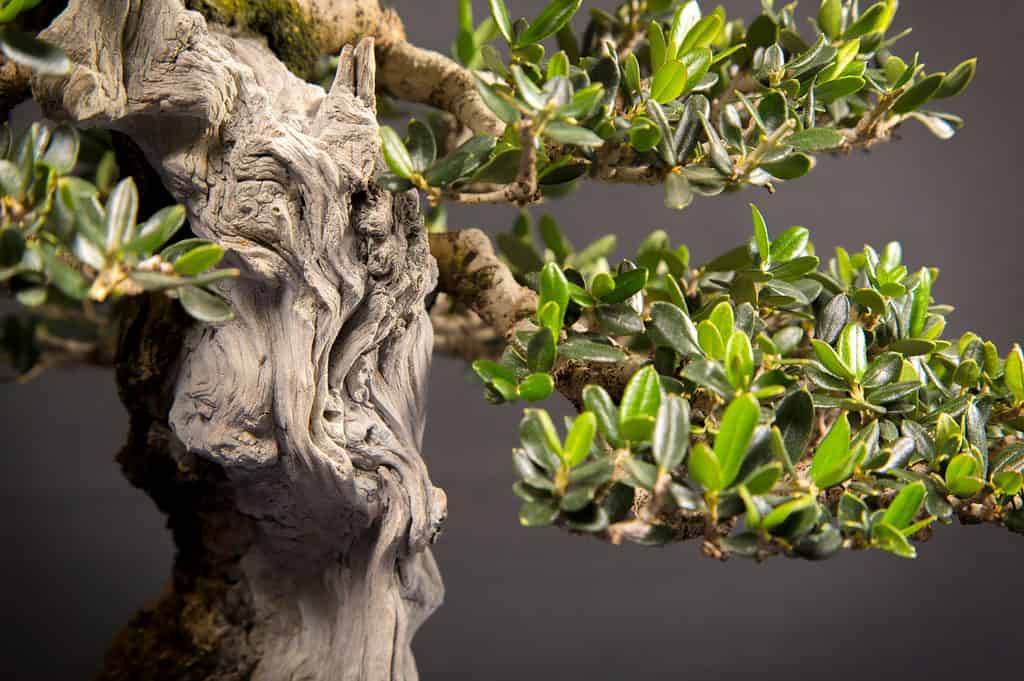
Caring for a Bonsai tree truly is an art form, especially when you take a look at all of the different possible styles used in traditional Bonsai tree formations.
©Luis Rojas Estudio/Shutterstock.com
Depending on the Bonsai tree species that you have, there are a number of different styles, shapes, and ways that you can design it to help thrive. Here are a number of different Bonsai styles for you to choose from, all inspired by the natural habitats that these trees grow in!
Chokkan

The formal upright Bonsai style creates a powerful statement in any container.
©iStock.com/N/A
One of the most common Bonsai tree styles to consider is Chokkan, or the formal upright style of Bonsai design. Depending on the species of tree that you choose, the formal upright Bonsai style creates a powerful statement in any container. With a single trunk kept straight and plenty of branches toward the top, there’s plenty of space to create a beautiful landscape surrounding your singular, thick tree trunk!
Moyogi

This trunk is shaped with curves and bends to it, often like the letter S.
©iStock.com/RenataKa
Also known as the informal upright style, Moyogi is similar to the formal upright style in that it has a single tree trunk. However, this trunk is shaped with curves and bends to it, often like the letter S. In addition, this style typically involves branches at each bend. The tree and foliage naturally flow with the curves.
Fukinagashi
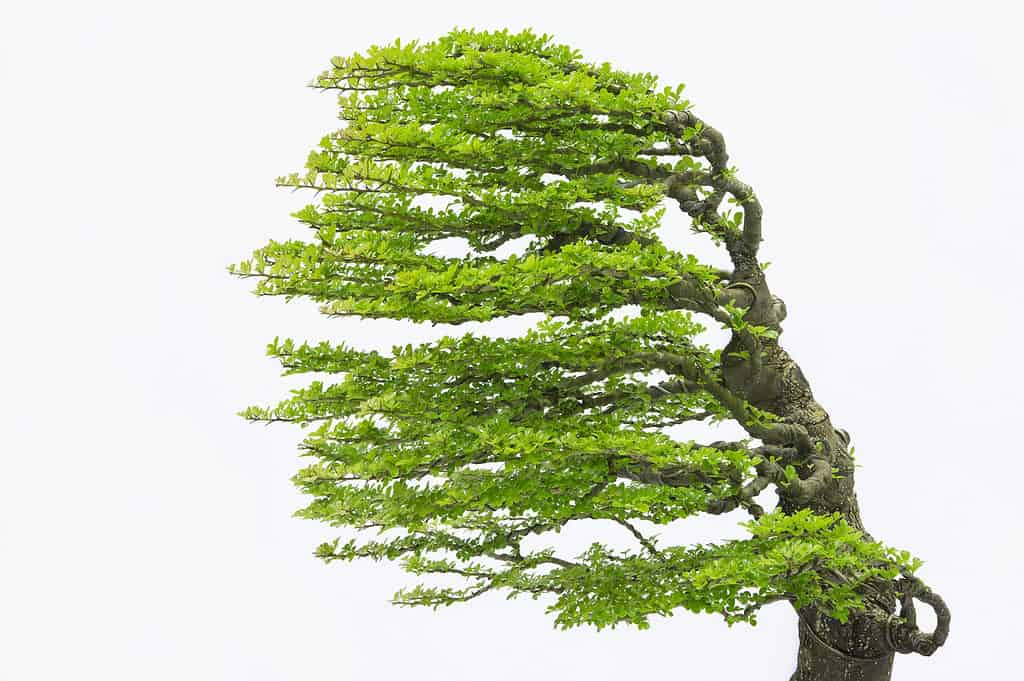
Depending on your skill level, a windswept Bonsai tree style may work well for you.
©Sukpaiboonwat/Shutterstock.com
Best suited for certain tree species such as cypress trees, the Fukinagashi Bonsai style requires that all of your Bonsai tree branches are shaped to one side. Also known as the windswept style, this Bonsai tree shape takes care and time to get it right. However, your Bonsai tree should appear as if it has been blown by the wind in one direction for its entire life, much like cypress trees found along coastlines around the world!
Yose-ue
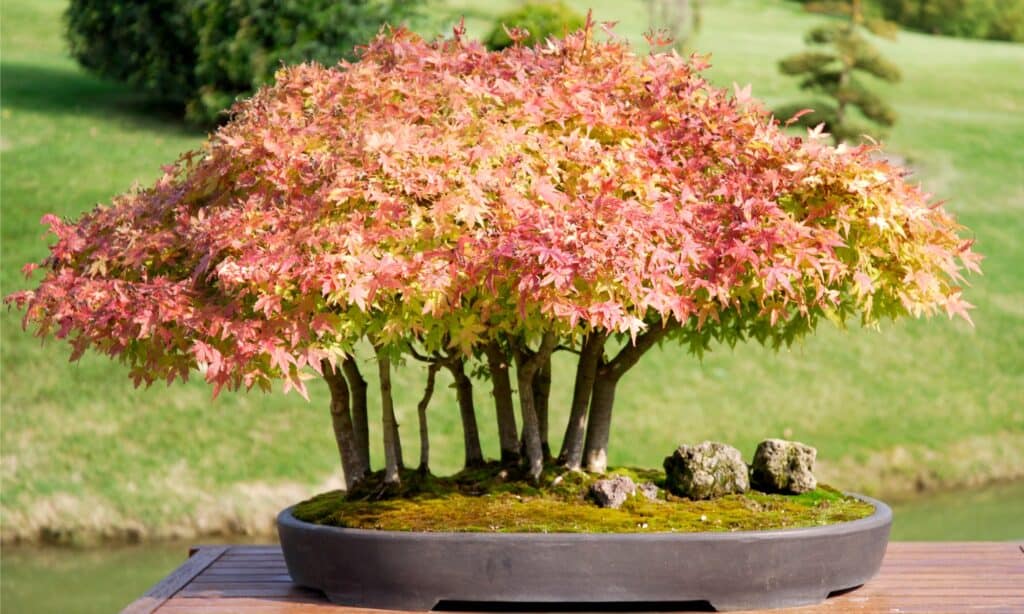
You are essentially crafting multiple Bonsai trees in a single pot!
©iStock.com/Musat
The forest Bonsai style is exceedingly popular for narrow tree trunk species such as birch. If you have a big enough container to create an entire scene, this is a great shape to consider. Many people choose to creatively design their Yose-ue Bonsai container so that the tree trunks are staggered, mimicking a forest found in nature. The canopies of these trees branch out and often join each other. You are essentially crafting multiple Bonsai trees in a single pot!
Sokan
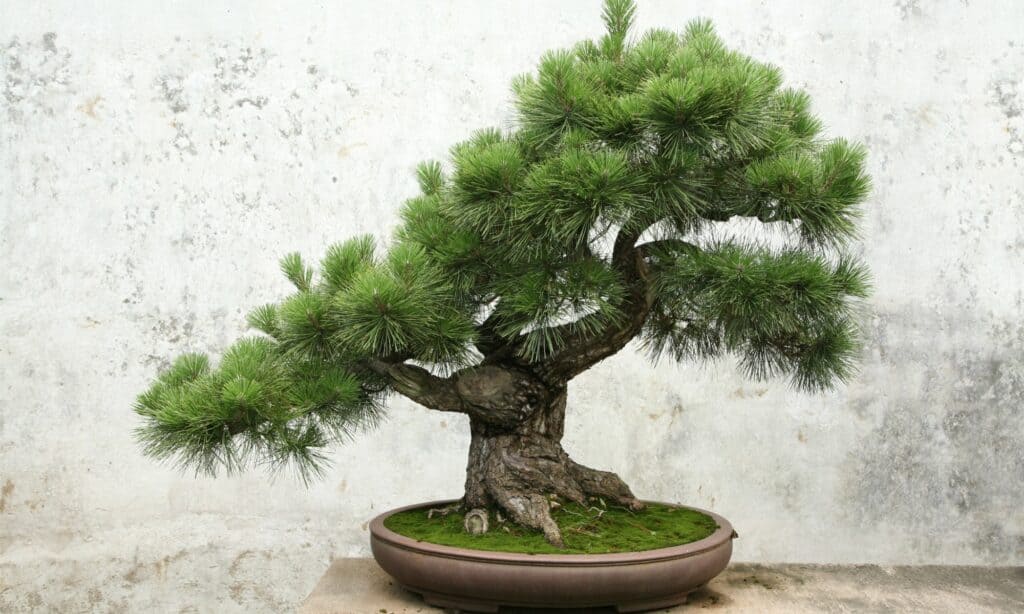
An easy style for beginners has to be the Sokan style.
©iStock.com/Banannaanna
A more advanced style of Bonsai shaping has to be at the double trunk or Sokan style. This involves your Bonsai tree splitting into two distinct trunks, often seen in tree species such as oak trees. Typically, one trunk remains straighter than the other, though both trunks create a large, unified canopy.
Kabudachi

Kabudachi involves crafting a Bonsai tree with multiple trunks.
©Asok Mathew/Shutterstock.com
Just like the Sokan style, Kabudachi involves crafting a Bonsai tree with multiple trunks. Any Bonsai tree that has more than two trunks is considered a Kabudachi style. You can craft as many trunks as you want, so long as they grow from a singular source. This differs from the forest styling method, as it is technically one single tree rather than multiple ones. Still, they reach for the same sky and create a beautiful, joint canopy.
Bunjingi

Crafting a Bonsai tree in this way involves oddly curving trunks and a distinct lack of branches.
©Thanun Patiparnthada/Shutterstock.com
Known as the Literati Bonsai style, Bunjingi is a particular mimicry of trees in forests that don’t receive enough light. Crafting a Bonsai tree in this way involves oddly curving trunks and a distinct lack of branches. The very tip of the tree should be bare and stretching to reach the light it so desperately craves in the wild! Many Bonsai artists choose to leave the tops of their Bunjingi trees stripped of bark. This illustrates an intense desire for survival.
Shakan
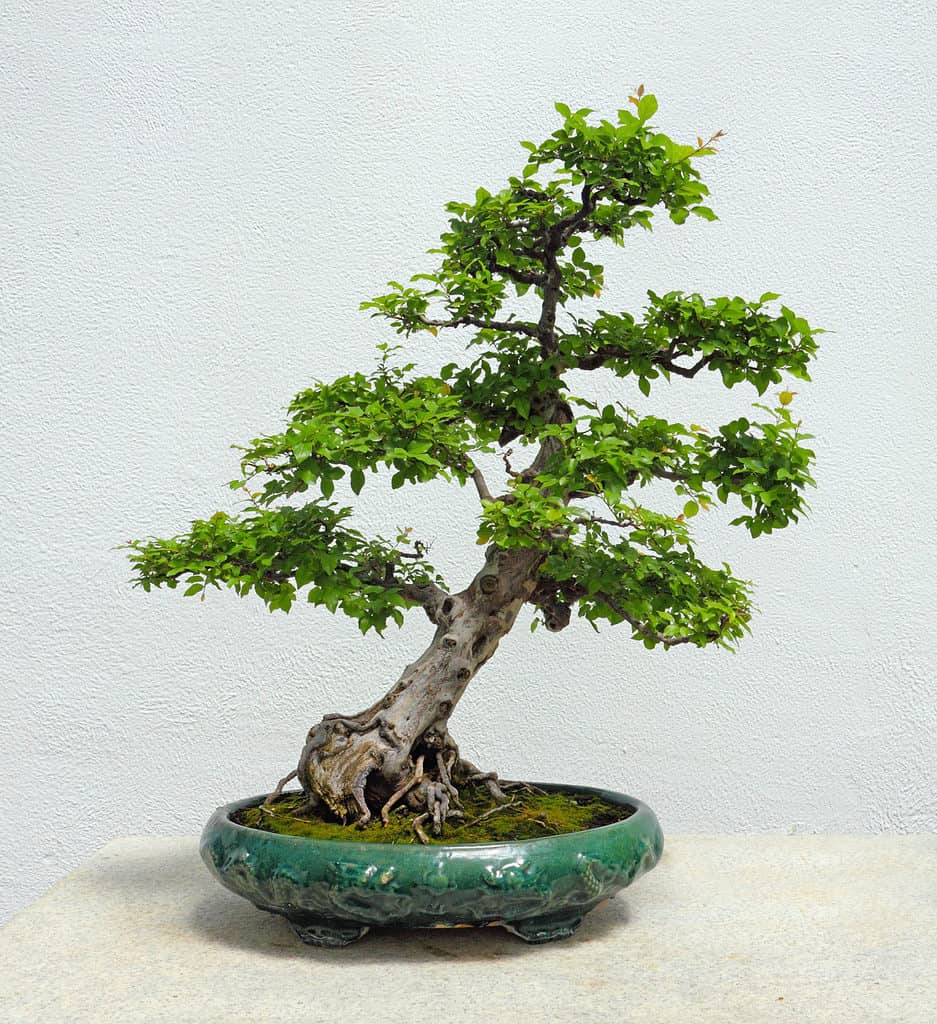
The Shakan style of Bonsai crafting is similar to the windswept style.
©Claude Huot/Shutterstock.com
Thicker at the base than at the top, the Shakan style of Bonsai crafting is similar to the windswept style. It has a distinctly angled trunk, leaning heavily to one side or the other in a straight line. However, this slanted tree shape needs its branches crafted with care so that it doesn’t look too unbalanced. The very bottom branch should stretch in the opposite direction of the trunk’s angled slant!
Han-kengai
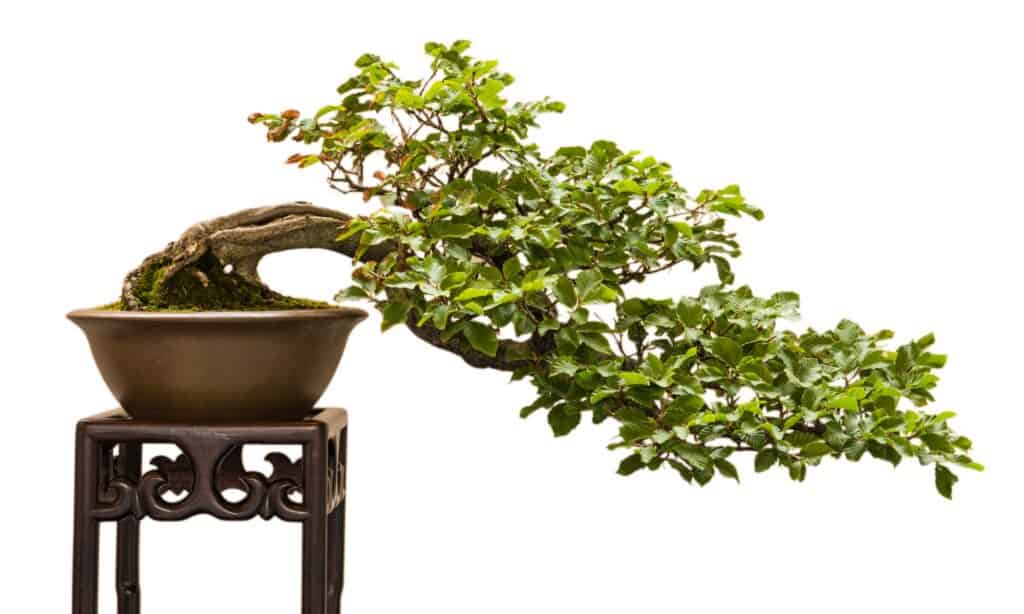
The semi-cascade style stops its descent before the branches reach the bottom of the pot.
©iStock.com/photohomepage
Delicate and distinct, the Han-kengai Bonsai style is also referred to as a semi-cascade style. It involves your Bonsai’s trunk growing normally for a few inches before taking a downward motion, or a slight downward cascade. The semi-cascade style stops its descent before the branches reach the bottom of the pot. Speaking of, tall and narrow pots are often chosen for this tree style, both for dramatic effect and to assist in your Bonsai tree’s downward growth!
Kengai

A full cascading Bonsai tree style is beautiful and artistic.
©Sukpaiboonwat/Shutterstock.com
If you enjoy the cascading effect offered by Han-kengai, then you’ll likely enjoy the full cascade effect offered by the Kengai style. Just like a semi-cascading Bonsai tree, full cascading Bonsai trees grow upward before beginning a stark descent. The tree and its branches continue falling until it reaches the very bottom of its container. It’s certainly more dramatic than its semi-cascading counterpart! Keep in mind that this is a fairly advanced Bonsai style to craft and shape. Cascading effects on trees typically happen when branches are weighed by rocks or snow in a natural habitat.
Hokidachi
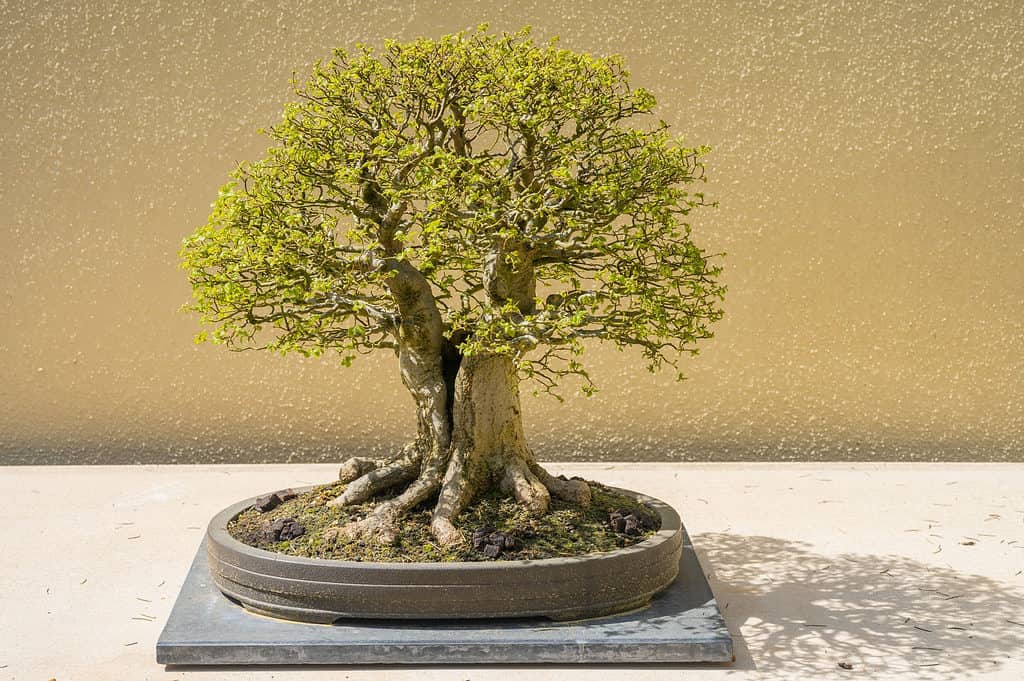
The tiny branches of most hackberry species make it a great broom Bonsai specimen.
©Mariusz S. Jurgielewicz/Shutterstock.com
Depending on the type of Bonsai tree you are cultivating, the Hokidachi style may suit you well. Also known as the broom style of Bonsai tree shaping, Hokidachi is best for trees with many branches, the smaller and more intricate the better. Oaks, azaleas, and boxwood Bonsai trees are gorgeous when shaped in a broom style. Their foliage creates a rounded crown and a full appearance. When the leaves fall, the naked branches are equally stunning in their intricate layout!
Ikadabuki

You can craft Bonsai trees out of old branches.
©Huy Thoai/Shutterstock.com
Broken trees can become Bonsai specimens too. While propagating a Bonsai tree can be easier said than done, the Ikadabuki or raft style of Bonsai crafting may suit you well. Created using a broken tree segment, the raft style of Bonsai shaping is unique. Lay the broken branch down and use it as your tree’s base. Any existing offshoots or branches will become multiple new tree trunks. These can form either a forest of Bonsai trees or join together to form one, uniform crown.
Sharimiki
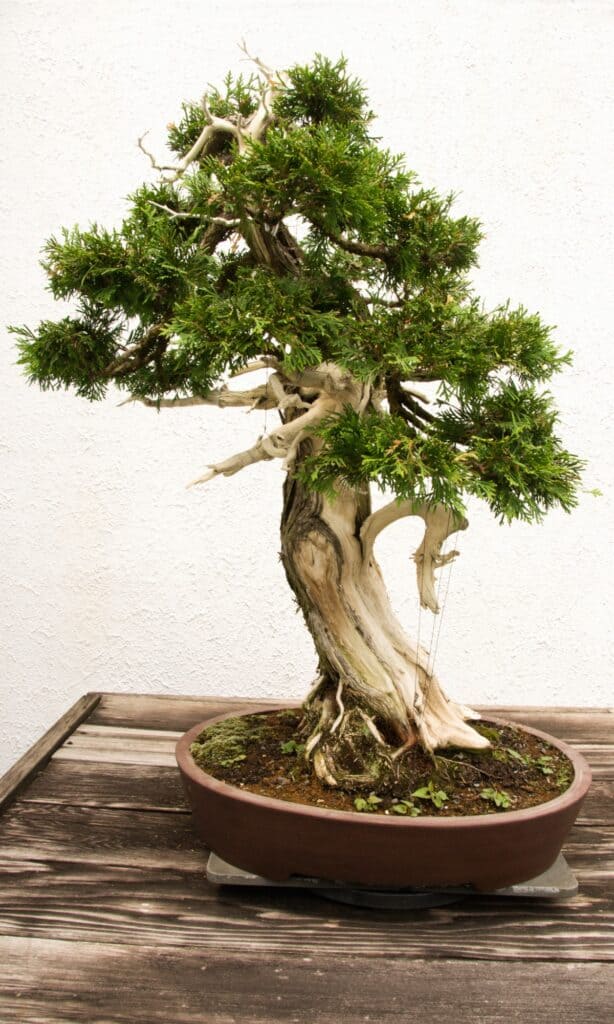
Cypress, redwood, and birch trees make great Sharimiki-style specimens.
©iStock.com/LCBallard
If you enjoy a weathered and slightly damaged look to your Bonsai tree, you should explore the Sharimiki method. Crafted either on purpose or to highlight the naturally damaged portions of your Bonsai tree, the Sharimiki shape reflects bleached and missing segments of bark on your tree. Cypress, redwood, and birch trees make great Sharimiki-style specimens, given their unique and weathered bark.
Ishisuki
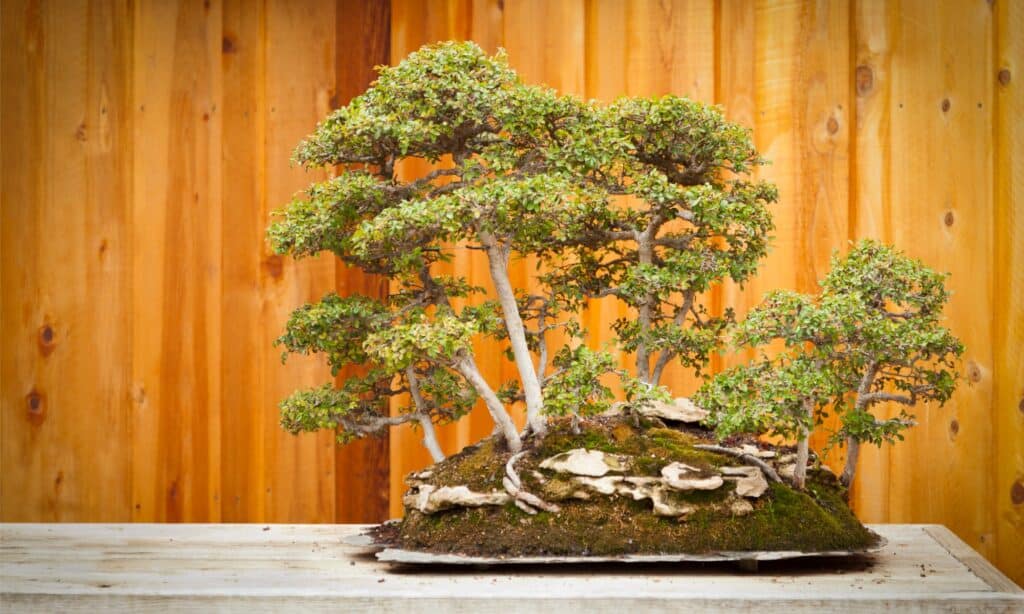
The fertilizing and watering requirements of Bonsai trees grown in this style are intense.
©iStock.com/Feverpitched
Another advanced Bonsai tree method has to be Ishisuki. This is the process of growing your Bonsai tree specimen within rocks or other porous stones. The root system grows through the rocks, which offer very little nutrients or sources of water. That’s why most Bonsai tree specimens shaped using this process are small and meant to look like they are struggling in their natural environment. The fertilizing and watering requirements of Bonsai trees grown in this style are intense. This likely isn’t a great starting style for beginners.
Seki-joju
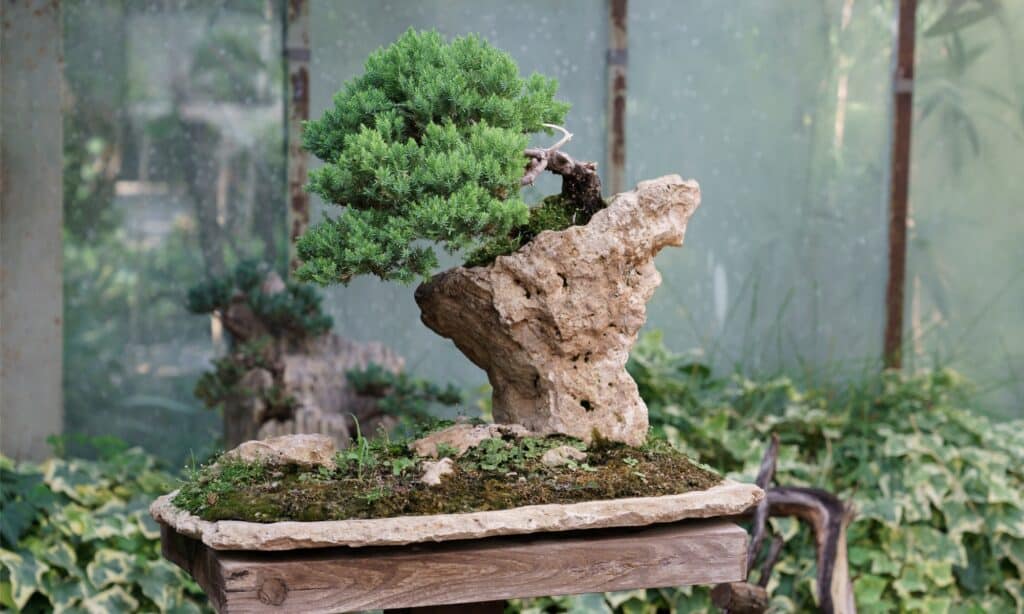
You can craft your juniper Bonsai to grow on rocks.
©iStock.com/Dima Berlin
Differing from Ishisuki, the Seki-joju Bonsai style is the art of growing your Bonsai tree on top of a rock rather than through a rock. Contrary to popular belief, this style isn’t necessarily more difficult than many other styles. Trees are naturally accustomed to growing over rocks in nature, after all. However, some species are better suited to this shape than others. Some of these trees include junipers, cypresses, and a variety of tropical trees such as umbrella trees or ficus trees.
Up Next:
- Discover The 20+ Different Types of Bonsai Trees
- How to Properly Place a Bonsai Tree
- The 10 Best Bonsai Trees for Beginners
The photo featured at the top of this post is © irinacapel/Shutterstock.com
Sources
- Penjing: The Chinese Art of Bonsai: A Pictorial Exploration of Its History, Aesthetics, Styles and Preservation, Available here: https://books.google.com/books?hl=en&lr=&id=eqhaEAAAQBAJ&oi=fnd&pg=PT42&dq=bonsai+tree+styles&ots=JN-G5fmmsi&sig=PiwZWQHSdbQiFS0ZKGRp2i2qtBM
- https://www.cabdirect.org/cabdirect/abstract/19600604411, Available here: https://www.cabdirect.org/cabdirect/abstract/19600604411
Thank you for reading! Have some feedback for us? Contact the AZ Animals editorial team.






